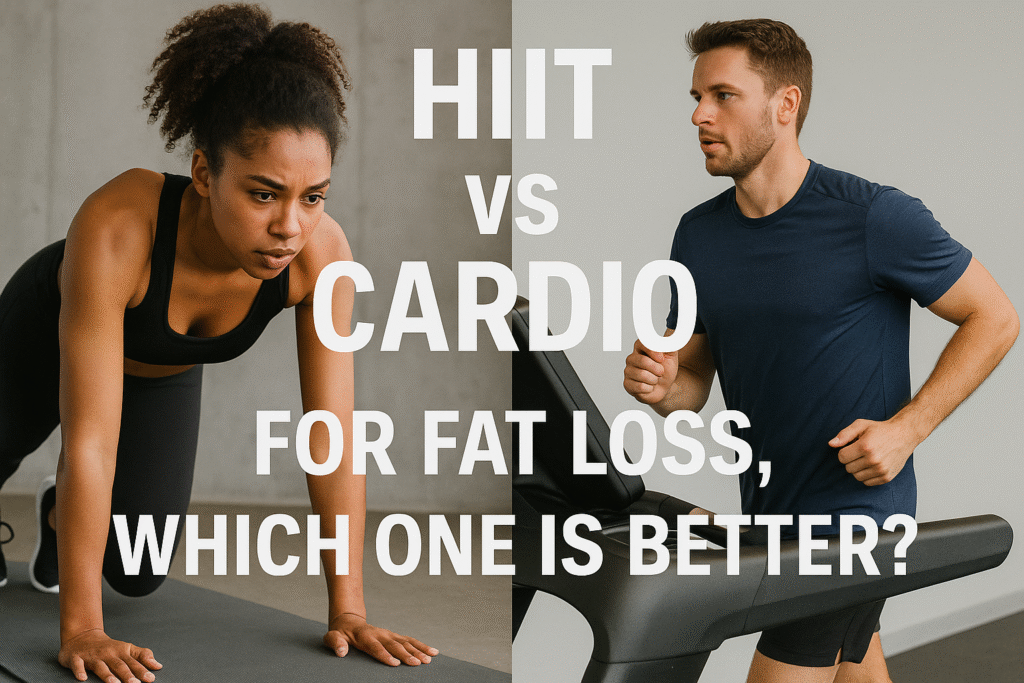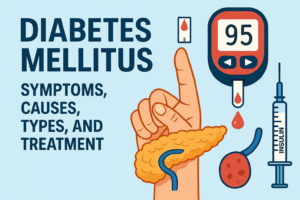HIIT vs Cardio for Fat Loss, Which One is Better for fast fat loss?

When it comes to losing fat, there are a ton of workout strategies to choose from. Among the most popular are two types of exercises: High-Intensity Interval Training (HIIT) and traditional cardiovascular exercise, or simply “cardio.” Both have their advantages, but when it comes to fat loss, which one should you go for?
Let’s take a closer look at what each of these workouts entails, their benefits, and how they compare when it comes to burning
What is Cardio?
Cardio, short for cardiovascular exercise, refers to any physical activity that increases your heart rate and keeps it elevated for a sustained period. It includes exercises like jogging, swimming, cycling, and even brisk walking. Cardio workouts are typically performed at a moderate intensity and can last anywhere from 30 to 60 minutes.
The main reason people often choose cardio for fat loss is straightforward: it helps burn calories. Steady-state cardio, which involves maintaining a constant pace throughout the workout, encourages your body to burn fat for energy, particularly during longer sessions. This makes cardio one of the most effective and traditional ways to get your body into fat-burning mode.
How Cardio Helps with Fat Loss:
When you do cardio, your body first uses up stored carbohydrates (glycogen) for energy. As your workout continues, especially if it lasts longer than 30 minutes, your body shifts to burning fat as its primary fuel source. This is why cardio is often recommended for anyone trying to lose weight.
The duration of your cardio session matters a lot here—longer sessions mean more fat burning. However, because the intensity is usually moderate, it takes time for your body to shift into fat-burning mode. So, while cardio is effective, it can be a slower process compared to more intense methods.
What’s HIIT?
High-Intensity Interval Training, or HIIT, is a workout method that alternates between short bursts of very high-intensity activity and brief rest periods or lower-intensity recovery. For example, you might sprint at full effort for 20 seconds, followed by a 10-second rest, and repeat for several rounds.
HIIT workouts can be done with all sorts of exercises, including sprinting, cycling, bodyweight exercises like burpees, or even weight training. The beauty of HIIT lies in its intensity, which pushes your body to its limits in a short amount of time.
How HIIT Helps with Fat Loss:
One of the reasons HIIT is so effective for fat loss is because it’s incredibly intense. This intensity forces your body to burn more calories during the workout itself, and it also leads to what’s known as the “afterburn effect.”
1. Afterburn Effect (EPOC): HIIT workouts cause an increased rate of calorie burn for hours after you finish. This phenomenon, known as Excess Post-Exercise Oxygen Consumption (EPOC), means that your metabolism stays elevated, helping you burn more calories even when you’re not working out.
2. Higher Calorie Burn in Less Time: HIIT workouts are intense and short—usually only 15 to 30 minutes. This means you’re burning more calories in less time compared to steady-state cardio, which can make it an attractive option for those with a busy schedule.
3. Fat Loss and Muscle Preservation: Another advantage of HIIT is that it helps preserve lean muscle mass. Unlike traditional cardio, which can sometimes lead to muscle loss, HIIT stimulates muscle-building hormones like human growth hormone (HGH), making it easier to maintain or even build muscle while burning fat.
Comparing HIIT and Cardio for Fat Loss
Now that we’ve broken down what each workout involves, let’s compare the two based on how effective they are for fat loss.
1. Calories Burned
Cardio: With steady-state cardio, the number of calories you burn depends on factors like your workout intensity, duration, and your body weight. For example, a 30-minute moderate-intensity cardio session could burn around 250 to 400 calories.
HIIT: Because HIIT is so intense, it burns more calories during the workout. A 20-minute HIIT session could burn anywhere from 200 to 400 calories, but what makes HIIT really special is the afterburn effect. After the workout, your body continues to burn calories at an elevated rate for hours.
Winner: HIIT. While both cardio and HIIT burn calories, HIIT gives you more bang for your buck—burning calories faster during the workout and continuing to burn them afterward.
2. Fat Burning
Cardio: Cardio is great for fat loss, but it’s a slow and steady process. During a long cardio session, your body gradually switches from burning glycogen to burning fat. The longer the session, the more fat you burn. However, once the session ends, the fat-burning effects stop.
HIIT: HIIT is more efficient in terms of fat loss. The intense bursts of activity push your body to burn fat quickly, and because of the afterburn effect, fat continues to be burned for hours after you finish. Essentially, it burns fat during the workout and keeps burning it after you’re done.
Winner: HIIT. The combination of high calorie burn and continued fat burning after the workout makes HIIT the winner here.
3. Muscle Preservation
Cardio: Long periods of steady-state cardio, especially when done excessively, can lead to muscle loss. If you’re doing hours of cardio a week without incorporating strength training, your body may break down muscle tissue for energy, especially if you’re in a calorie deficit.
HIIT: On the other hand, HIIT is much better for preserving muscle mass. The high intensity of HIIT workouts helps stimulate muscle-building hormones like HGH, which can help prevent muscle breakdown while promoting fat loss. This is especially true if you combine HIIT with some weight training.
Winner: HIIT. It’s better for maintaining lean muscle while also burning fat, which is a huge bonus if you’re aiming for a leaner, more toned physique.
4. Time Efficiency
Cardio: A typical cardio workout lasts anywhere from 30 to 60 minutes. This can be a lot of time to commit, especially if you have a busy schedule. However, some people find that longer sessions help them unwind or clear their minds, so the time commitment might be worth it.
HIIT: HIIT workouts are usually shorter—about 15 to 30 minutes. Despite their shorter duration, they’re just as, if not more, effective than long cardio sessions. This makes HIIT a great option for those who need an efficient workout that doesn’t take up much time.
Winner: HIIT. If you’re short on time, HIIT provides a much quicker, yet effective, workout.
5. Sustainability
Cardio: Cardio is easier to sustain over the long term. It’s less intense, and it doesn’t place as much stress on the body, so many people can comfortably do it for extended periods. It’s also easier for beginners to ease into, making it a good choice for those just starting their fitness journey.
HIIT: HIIT, on the other hand, is more demanding. While it’s incredibly effective, it can be tough on the body, especially for beginners or those new to exercise. Overdoing it can lead to burnout, so it’s essential to allow for proper recovery between sessions.
Winner: Cardio. For consistency and ease of implementation, cardio is the better long-term choice for many people. It’s less intense and easier to incorporate into a daily routine.
So, Which One Should You Choose?
There’s no one-size-fits-all answer here. It all depends on your goals, fitness level, and how much time you have available.
If you’re short on time and want to burn fat quickly, HIIT is likely your best bet. It’s intense, efficient, and effective in both calorie burning and fat loss.
If you prefer a more sustainable, lower-impact workout, or if you’re just getting started, cardio might be a better fit for you. It’s easier to sustain over longer periods and still provides solid fat-burning benefits.
For the best of both worlds, many fitness experts recommend a balanced approach. Combining both HIIT and cardio can help you take advantage of the strengths of each. You might do HIIT a couple of times a week for maximum fat burn, and fit in some cardio sessions on other days to maintain endurance.






